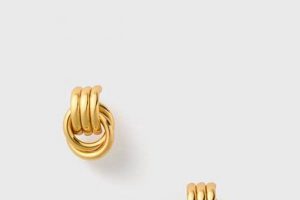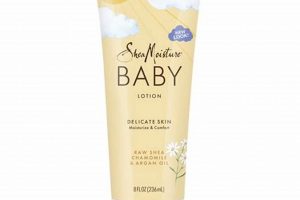A breast pump component, these accessories connect the breast shield to the collection bottle. They are crucial in creating a closed system that allows for efficient milk expression. Incorrect sizing or improper use can lead to discomfort and reduced milk output, demonstrating the significance of selecting the appropriate size and ensuring correct attachment.
Optimal flange fit is essential for comfortable and effective pumping. Proper sizing promotes efficient milk removal, potentially increasing milk supply and minimizing nipple trauma. Historically, a universal size was common, but now a range of sizes addresses the diverse anatomy of breastfeeding individuals, leading to improved pumping experiences and outcomes.
Therefore, the following sections will delve into the nuances of choosing the correct size, understanding compatibility with different pump models, and troubleshooting common issues encountered during pumping sessions. These considerations ultimately contribute to a successful and comfortable breastfeeding or pumping journey.
Optimizing Breast Pumping Performance
Maximizing the effectiveness and comfort of breast pumping necessitates careful consideration of several factors. The following tips offer guidance on optimizing the pumping experience to achieve desired outcomes.
Tip 1: Ensure Proper Sizing. Accurate nipple measurement is paramount. A flange size that is too small can cause pain and restrict milk flow, while one that is too large may result in insufficient suction and inefficient milk extraction. Re-evaluate sizing as needed, as nipple size can fluctuate.
Tip 2: Prioritize Comfort. Pumping should not be a painful process. If discomfort is experienced, reassess flange size and suction settings. Consider using a lubricant designed for breastfeeding to reduce friction and improve comfort.
Tip 3: Verify Secure Attachment. A secure seal between the flange and the breast is crucial for maintaining adequate suction. Ensure the flange is positioned correctly and that there are no gaps that could compromise the vacuum seal.
Tip 4: Adjust Suction Settings Appropriately. Start with the lowest suction setting and gradually increase until a comfortable and effective level is achieved. Excessive suction can lead to nipple trauma and reduced milk output.
Tip 5: Maintain Equipment Hygiene. Regular cleaning and sterilization of all pump parts, including the flanges, are essential for preventing bacterial contamination and ensuring the safety of expressed milk. Follow manufacturer guidelines for proper cleaning procedures.
Tip 6: Consider Hands-On Pumping. Employing hands-on pumping techniques, such as breast massage or compression, can help stimulate milk flow and improve overall milk output. Combine manual techniques with mechanical pumping for enhanced results.
These strategies underscore the importance of personalized adjustments and diligent practices to optimize the breast pumping process. Careful attention to these details can promote a more comfortable and efficient milk expression experience.
In conclusion, implementing these practical tips can significantly contribute to a more positive and productive pumping journey, ultimately supporting breastfeeding goals and infant nutrition.
1. Proper Sizing
The selection of appropriately sized breast pump flanges is fundamental to successful and comfortable milk expression when utilizing pumping systems. Incompatibility between flange size and individual anatomy can lead to various adverse outcomes.
- Effective Milk Removal
Correct flange sizing ensures optimal suction and complete emptying of the breast. Undersized flanges can compress the nipple, hindering milk flow and causing discomfort. Oversized flanges may draw in excessive areolar tissue, resulting in inefficient milk extraction and potential tissue damage. Matching the flange size to the nipple diameter facilitates effective and comfortable milk removal.
- Nipple Health and Comfort
Appropriate flange sizing minimizes the risk of nipple trauma, including blistering, cracking, and pain. Incorrect sizing can cause friction and excessive pressure on the nipple, leading to skin breakdown and discomfort. Selecting the correct size promotes a comfortable pumping experience and helps maintain nipple integrity throughout the lactation period.
- Milk Supply Maintenance
Consistent and effective milk removal, facilitated by properly sized flanges, is essential for maintaining an adequate milk supply. Inefficient pumping due to incorrect flange size can signal the body to reduce milk production. Optimal flange fit supports regular breast emptying, stimulating ongoing milk synthesis and sustaining a robust milk supply.
- Reduced Pumping Time
When flanges fit correctly, milk flows more freely and efficiently, reducing the overall pumping time required to empty the breasts. Incorrect sizing can lead to prolonged pumping sessions and incomplete milk removal, increasing the time commitment associated with breast pumping. Proper flange selection contributes to a more streamlined and time-efficient pumping process.
These facets highlight the integral relationship between flange size and the overall pumping experience. A commitment to proper flange selection supports comfortable, efficient, and sustainable milk expression for individuals utilizing pumping systems.
2. Material Composition
The selection of materials for breast pump flanges directly impacts safety, functionality, and comfort. Predominantly, flanges are constructed from polypropylene, silicone, or occasionally, BPA-free plastics. Polypropylene offers rigidity and durability but may not provide the same level of comfort as silicone. Silicone, with its flexible and soft characteristics, conforms more readily to the breast’s contours, potentially enhancing suction and reducing discomfort during milk expression. The absence of Bisphenol A (BPA) in plastic flanges is a critical safety consideration, mitigating the risk of chemical leaching into breast milk. Material choice affects flange lifespan, cleaning protocols, and the overall user experience. For instance, silicone flanges, while more comfortable, may degrade more quickly than polypropylene under repeated sterilization.
Material properties also influence the efficiency of milk extraction. The pliability of silicone can create a more secure seal against the breast, optimizing suction and milk flow. Conversely, the rigid structure of polypropylene flanges might require more precise positioning to achieve the same level of seal integrity. Real-world examples reveal a preference for silicone flanges among users who experience nipple sensitivity or discomfort with harder materials. However, the durability of polypropylene flanges is often favored by individuals seeking long-term use and resistance to wear and tear from frequent sterilization processes.
Ultimately, material composition represents a pivotal design element influencing the performance and suitability of breast pump flanges. Navigating the trade-offs between comfort, durability, and safety enables informed decision-making, contributing to a more positive and efficient breastfeeding experience. The selection process necessitates a comprehensive understanding of the implications associated with each material type and their potential impact on both maternal well-being and infant health.
3. Compatibility
The operational effectiveness of breast pump flanges hinges significantly on their compatibility with specific pump models and individual user needs. Mismatched components can compromise suction, comfort, and overall pumping efficiency, underscoring the critical importance of verifying compatibility.
- Pump Model Compatibility
Flange design varies across different breast pump manufacturers and models. The connection mechanism, diameter, and thread patterns must align precisely for proper attachment and suction. Attempting to use incompatible flanges can result in air leaks, reduced milk expression, and potential damage to the pump motor. Always consult the pump manufacturer’s specifications or compatibility charts to ensure correct flange selection. Some flanges may require adapters for use with specific pumps.
- Connector and Tubing Integration
Flanges connect to the breast pump via tubing and connectors. The inner diameter and material of these components must be compatible with the flange to maintain consistent suction and prevent air leaks. Ill-fitting connectors can compromise the integrity of the closed system, increasing the risk of contamination and reducing pumping effectiveness. Ensuring proper connector size and secure attachment are crucial for optimal performance.
- Personal Anatomical Fit
Compatibility extends beyond pump model to include anatomical compatibility. Flange size must correspond to nipple diameter to avoid discomfort and maximize milk removal. While a flange may be technically compatible with a pump, an improper fit relative to the individual’s anatomy can negate its benefits. This necessitates careful measurement and consideration of various flange sizes to identify the most appropriate option for comfortable and effective pumping.
- Material and Cleaning Compatibility
Flanges are typically manufactured from materials such as silicone or polypropylene. Cleaning and sterilization methods must be compatible with the flange material to prevent degradation or damage. Certain cleaning agents or high-temperature sterilization processes can compromise the structural integrity of incompatible materials, leading to leaks or reduced lifespan. Always adhere to the manufacturer’s recommended cleaning protocols to maintain flange integrity and hygiene.
These considerations collectively underscore the multifaceted nature of compatibility in relation to breast pump flanges. Ensuring compatibility across pump models, connectors, anatomical fit, and cleaning methods is paramount for maximizing pumping efficiency, comfort, and safety. Comprehensive assessment of these factors is essential for informed decision-making and successful breast milk expression.
4. Seal Integrity
Seal integrity is a critical determinant of performance when utilizing breast pump flanges. The presence of a reliable seal between the flange and the breast is paramount for generating and maintaining the suction necessary for efficient milk expression. Compromised seal integrity can lead to reduced suction, extended pumping sessions, and potential discomfort for the user.
- Vacuum Generation Efficiency
An intact seal creates a closed system, allowing the breast pump to generate and sustain a vacuum. Breaches in seal integrity, such as gaps between the flange and the breast, permit air leakage, reducing the vacuum pressure and impairing milk extraction. Effective vacuum generation is contingent upon a fully sealed interface.
- Milk Flow Optimization
A consistent vacuum, facilitated by a robust seal, promotes optimal milk flow from the breast. Interruptions in the vacuum due to seal compromise can result in intermittent or reduced milk flow. The continuous application of suction, enabled by an airtight seal, is essential for effective breast emptying.
- Comfort and Nipple Protection
A properly sealed flange distributes suction evenly across the areola and nipple, minimizing localized pressure points and reducing the risk of tissue trauma. Seal compromise can lead to uneven suction distribution, potentially causing discomfort or nipple damage. Maintaining seal integrity contributes to a more comfortable and protective pumping experience.
- Hygiene and Contamination Prevention
An intact seal minimizes the potential for external contaminants to enter the expressed milk. Gaps in the seal can allow airborne particles or bacteria to infiltrate the collection system, compromising the hygiene of the breast milk. A secure seal is an integral component of a closed system, helping to maintain milk purity and safety.
These facets collectively underscore the significance of seal integrity in relation to breast pump flanges. Prioritizing a secure and airtight seal ensures optimal suction, efficient milk flow, user comfort, and hygienic milk collection. Maintaining seal integrity is a foundational aspect of effective breast pumping practices, directly influencing the success and sustainability of breastfeeding efforts.
5. Ease of cleaning
The ease with which these components can be cleaned significantly impacts hygiene and the long-term health of both mother and child. Residue from breast milk can foster bacterial growth, potentially leading to infections if cleaning is inadequate. Design features such as smooth surfaces, minimal crevices, and dishwasher-safe materials contribute to simplifying the cleaning process. Complex designs with hard-to-reach areas increase the risk of bacterial contamination, necessitating more rigorous cleaning procedures. Real-life examples demonstrate that flanges with simpler designs are more frequently and thoroughly cleaned, leading to a reduced incidence of bacterial contamination in expressed milk. The practical significance of understanding this connection is that choosing flanges with ease of cleaning in mind directly mitigates health risks associated with breast milk contamination.
Material selection further influences cleaning protocols. Silicone flanges, while often more comfortable, may require more frequent replacement due to potential residue buildup or material degradation from sterilization processes. Polypropylene flanges, typically more rigid, often withstand rigorous cleaning and sterilization without significant degradation. The compatibility of flange materials with various cleaning methods, such as steam sterilization, boiling, or dishwasher cycles, determines the efficiency and effectiveness of cleaning procedures. Manufacturers typically provide specific cleaning guidelines to ensure proper hygiene and prevent damage to the flanges. Failure to adhere to these guidelines can compromise the integrity of the flanges and increase the risk of bacterial contamination.
Ultimately, the ease of cleaning represents a crucial aspect of these components, directly impacting hygiene, user compliance, and long-term health outcomes. Challenges include the time commitment associated with rigorous cleaning and the potential for overlooking hard-to-reach areas. Selecting flanges with user-friendly designs and materials compatible with effective cleaning methods is essential for promoting safe and hygienic breast milk expression, aligning with the broader theme of optimizing breastfeeding and infant health.
6. Durability
The inherent durability of these breast pump components directly influences their cost-effectiveness and long-term reliability. Repeated use and sterilization cycles place significant stress on flange materials, leading to potential degradation. Reduced durability necessitates frequent replacements, increasing operational costs and potentially disrupting breastfeeding routines. For example, a flange constructed from substandard material may crack or warp after a limited number of sterilization cycles, rendering it unusable. Conversely, flanges designed with high-quality, resilient materials demonstrate extended lifespans, providing sustained performance and minimizing the need for frequent replacements. The practical significance of prioritizing durability lies in its capacity to mitigate long-term costs and ensure consistent, reliable breast milk expression.
Material composition plays a critical role in determining flange durability. Medical-grade silicone and robust, BPA-free plastics are commonly employed in the construction of durable flanges. These materials exhibit resistance to heat, chemicals, and physical stress, enabling them to withstand repeated sterilization and use without significant degradation. Design features such as reinforced edges and seamless construction further enhance durability by minimizing stress points and reducing the risk of cracking or tearing. Consider the case where flanges are subjected to daily sterilization in a hospital setting; those constructed from durable materials maintain their structural integrity for a significantly longer period compared to less robust alternatives. The operational implication is that investments in durable flanges translate directly into reduced equipment replacement costs and improved operational efficiency.
In summary, the durability of these components constitutes a critical factor impacting both economic viability and operational reliability. The use of high-quality materials, coupled with thoughtful design considerations, ensures extended lifespans and sustained performance. Understanding the link between durability and long-term cost-effectiveness empowers informed decision-making, supporting consistent and reliable breast milk expression. Prioritizing durability mitigates financial burdens, reduces disruptions to breastfeeding routines, and contributes to the overall sustainability of breastfeeding support efforts.
7. Ergonomic Design
Ergonomic design considerations are pivotal in the context of breast pump flanges, directly impacting user comfort, pumping efficiency, and the overall breastfeeding experience. Optimal ergonomic design aims to minimize strain, reduce discomfort, and facilitate proper usage, thereby supporting successful and sustainable breastfeeding practices.
- Flange Shape and Contour
The shape and contour of a breast pump flange significantly influence its fit and comfort. Ergonomically designed flanges feature a curved or angled shape that conforms naturally to the breast, minimizing pressure points and promoting a secure seal. Standard flange shapes may not accommodate the diverse range of breast sizes and shapes, leading to discomfort and reduced pumping efficiency. For instance, a flange with a wide, shallow shape may better suit breasts with a broader base, while a narrower, deeper flange may be more comfortable for smaller breasts. This variability underscores the importance of considering anatomical diversity in flange design.
- Material Flexibility and Softness
The material from which a flange is constructed directly impacts its comfort and adaptability. Ergonomically designed flanges often incorporate soft, flexible materials, such as silicone, which conform readily to the breast’s contours. This pliability minimizes friction and pressure, reducing the likelihood of nipple irritation and discomfort. Rigid plastic flanges may cause localized pressure and discomfort, particularly during prolonged pumping sessions. The choice of material directly influences the user’s experience and ability to sustain consistent pumping routines.
- Easy Handling and Attachment
Ergonomic considerations extend to the ease with which a flange can be handled and attached to the breast pump. Flanges designed with a user-friendly grip and intuitive attachment mechanisms reduce the risk of fumbling or improper assembly. A secure and stable attachment is crucial for maintaining consistent suction and preventing air leaks, which can compromise pumping efficiency. Flanges with complex or cumbersome attachment mechanisms may increase the risk of user error and negatively impact the overall pumping experience.
- Weight and Balance
The weight and balance of a breast pump flange impact user fatigue and comfort, particularly during extended pumping sessions. Ergonomically designed flanges are lightweight and well-balanced, minimizing strain on the hand and wrist. Heavy or poorly balanced flanges may contribute to muscle fatigue and discomfort, making pumping less sustainable. The weight distribution of the flange relative to the breast pump body also affects stability and reduces the likelihood of accidental detachment during use.
These ergonomic design facets collectively contribute to the user-friendliness and effectiveness of breast pump flanges. Prioritizing ergonomic considerations ensures that pumping is a comfortable, efficient, and sustainable activity, supporting successful breastfeeding outcomes. The thoughtful integration of these elements optimizes the user experience, encouraging consistent adherence to pumping routines and promoting long-term breastfeeding success.
Frequently Asked Questions
The following questions address common concerns and misconceptions regarding these breast pump components.
Question 1: What determines the appropriate size for flanges used with the Baby Buddha pump?
Flange size is determined by nipple diameter, not breast size. A properly sized flange allows the nipple to move freely within the tunnel without excessive areolar tissue being drawn in. Nipple measurement guides are available from various sources to assist in determining the correct size.
Question 2: Are Baby Buddha flanges universally compatible with other breast pump brands?
Compatibility varies. While some flanges may be adaptable with other pumps using connectors, it is crucial to verify compatibility with the specific pump model to ensure proper suction and prevent damage to the pump motor. Consult pump manufacturers’ guidelines for compatibility information.
Question 3: What materials are commonly used in the construction of Baby Buddha flanges?
Common materials include silicone and BPA-free polypropylene. Silicone offers flexibility and comfort, while polypropylene provides durability and resistance to heat during sterilization. Material selection impacts the overall lifespan and cleaning requirements of the flange.
Question 4: How frequently should Baby Buddha flanges be replaced?
Replacement frequency depends on usage and material degradation. Inspect flanges regularly for signs of wear, such as cracks, warping, or loss of elasticity. Replacement is recommended every 3-6 months, or sooner if damage is observed.
Question 5: What are the recommended cleaning and sterilization procedures for Baby Buddha flanges?
Flanges should be cleaned after each use with warm, soapy water. Sterilization can be achieved through boiling, steaming, or using a microwave sterilization bag. Adhere to the manufacturer’s guidelines for specific cleaning and sterilization recommendations to prevent damage to the flanges.
Question 6: What issues indicate the need for a different flange size?
Signs of incorrect flange sizing include nipple pain, insufficient milk expression, excessive areolar tissue being drawn into the flange, and nipple blanching. Addressing these issues promptly through proper flange sizing supports comfortable and effective pumping.
Proper flange selection, cleaning, and maintenance are vital for optimal pumping outcomes and maternal well-being.
The following section will delve into troubleshooting common issues encountered while using breast pump flanges.
Conclusion
This exploration has detailed the importance of understanding the nuances associated with breast pump flanges. Key considerations include proper sizing, material composition, compatibility, seal integrity, ease of cleaning, durability, and ergonomic design. Each aspect contributes significantly to the efficiency, comfort, and hygiene of breast milk expression. Recognizing these elements supports informed decision-making and optimizes the pumping experience.
Ultimately, the selection and maintenance of breast pump flanges are integral to successful breastfeeding outcomes. Prioritizing these components is essential for maternal well-being and infant nutrition. Continuous awareness and adherence to best practices ensure a sustainable and positive breastfeeding journey.







